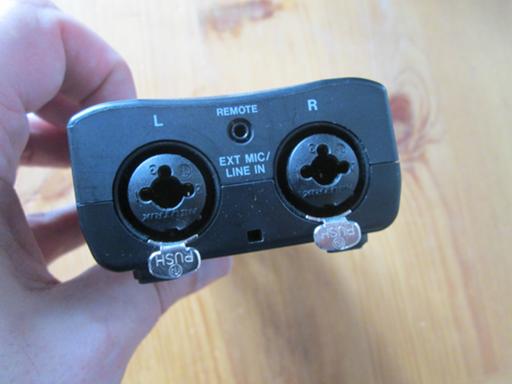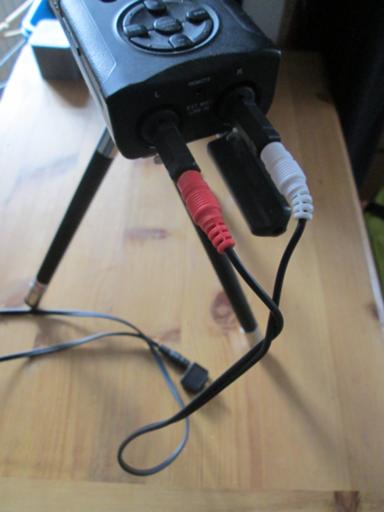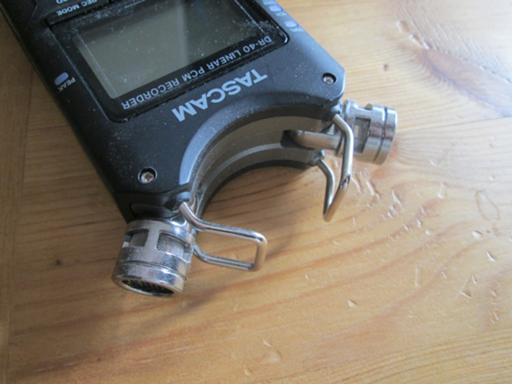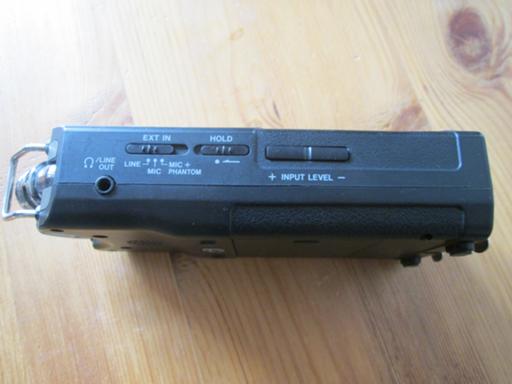The Tascam DR-40 is a four-track digital recorder that I'm using for
podcasting and game session recording.

It's a way in which the existence of YouTube has made my life better.
People think they're going to make their fortunes making videos, but
the audio recording quality on most video cameras isn't all that
great, so they want a dedicated audio recorder as well. This is that
recorder.
It's one of three models with similar capabilities. The cheaper DR-05
is a two-track recorder with built-in microphones, but no external
inputs; the DR-40 has two built-in microphones and two hybrid (¼" TRS
or XLR) sockets; the DR-60, about the same price as this, has no
built-in microphones, two hybrid sockets, and a single ⅛" stereo input
(and some functions to make it work better with a video camera).
Tascam makes the manuals for all its kit freely available, so it's
easy to work out which one might suit you.

The DR-40 seems to offer the most flexibility, so that's what I
bought. It can even provide phantom power on XLR, though this will be
hard on the batteries. What it won't do is power a standard cheap
"computer microphone", such as the boundary mics I've been using
before; I'm still looking for a solution to this, but may well end up
buying XLR mics.
In pure stereo mode, I use it for recording the main body of the
podcast, as well as for interviews away
from home. I mount it on a small tripod for convenience (it has a
standard ¼" threaded socket); it can be used hand-held, and has fairly
good isolation, but noise from contact is always a concern. There's a
small prop hidden inside the battery compartment, but even then the
unit doesn't sit flat on a table.
I record videoconferences on appear.in or Google Talk, such as my
role-playing sessions with
Whartson Hall,
by pointing the built-in microphones towards me for tracks 1 and 2,
then splitting the sound output from everyone else into both a pair of
headphones for me and the line inputs for tracks 3 and 4.

If they think you're crude, go technical; if they think you're
technical, go crude. I'm a very technical boy. […] These days,
though, you have to be pretty technical before you can even aspire
to crudeness.
It's all distressingly analogue, and the recording of me isn't off the
same mic as the one that's getting sent to the other participants, but
it gets the job done in a way that my software-fiddling with jack
has so far failed to accomplish. Afterwards it's trivial to mix the
tracks together.
For people who Really Care about this stuff, you can move the internal
microphones from their standard crossover (XY) pattern to an
outward-pointing (AB) pattern.

You can record at up to 96kHz in up to 24 bit resolution. Recording is
to an SD card up to 128G, and I've found it a little picky about
media, but reliable once it's got a card it likes. (You can record
compressed, but why would anyone want to do that? Four tracks at
maximum frequency and resolution will still take eight hours to fill a
32G card, which is about as long as the batteries will last anyway. In
my workflow, compression is a thing I do after I've got the sound as
good as I can get it in editing.)
Input levels can be set manually, or you can let the machine do it on
its own, or just tell it to compress loud sounds to prevent clipping.
Recording can be from the built-in microphones, the jacks, or both; if
you're only recording two tracks, you can automatically drop a backup
recording at a lower level onto the other pair of tracks in case of
excessive volume.

There are also built-in overdub modes (to add new content to a
recorded file, or to record the new content separately), a mixer, some
reverb effects… for me this is mostly stuff to be done later in the
editing software, but if I didn't have that I suppose this might be
useful. (For example, if I ever want to multi-track my own voice
against itself, I may well use the "overdub separate" mode to get my
timing right against a guide track, if only because then I don't have
to have a computer in the recording room as well as everything else.
But then I'll combine all the tracks in audacity.) Playback, not what
this thing is really designed for, is through a single rear speaker or
a ⅛" headphone socket.
For outdoor recording, the built-in low-cut filter can help eliminate
wind noise, but a dead cat (or Don King) windgag will do a better job
There's even a guitar tuner built in. Alas, that's the only mode where
you can invert the screen, so that you can read it when the
microphones are pointing towards you. I could have done with this in
other modes too; it seems that the target user of this kit is expected
to be recording other people, rather than himself.
Getting files off the recorder can be done via USB2, or simply by
turning the thing off and transferring the SD card. Power comes from
three AA batteries, or USB; I use NiMH rechargeables and get about
10-15 hours out of a set in two-channel mode, though I usually change
and charge them after a single session just to be on the safe side.
The case is mostly plastic, but it feels solid.
This is strictly a recording device, please note: it won't act as a
USB-based audio interface to a computer, or stream anything anywhere.
There is a DR-44WL model which streams over 802.11 to smartphone or
computer; I'm not interested in live audio, and I feel no urge to try
it, especially as giving it IP connectivity opens it to whole new
classes of attack which needn't be considered for a mere unconnected
device like the DR-40. Tascam is not a computer security company.
I haven't talked about sound quality. Well, it's hard to screw that up
these days, and Tascam hasn't. Noise floors are beautifully low on
internal or external feeds, but if you don't have a proper studio
available you'll probably still want to record the traditional
ten-second silence and do noise reduction on what you get out of the
machine.
Comments on this post are now closed. If you have particular grounds for adding a late comment, comment on a more recent post quoting the URL of this one.